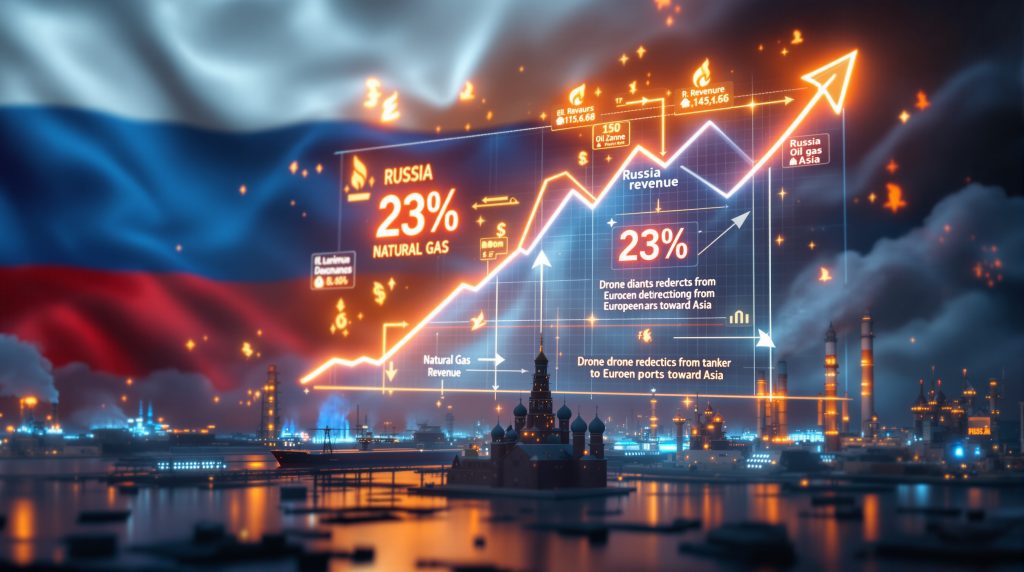Russia's Oil and Gas Revenue Decline: Economic Impact and Future Outlook Russia's oil and gas revenues are experiencing a significant downturn in 2025, with projections showing a 23% year-over-year decline for September alone. This sharp decrease represents part of a broader pattern that has seen energy-related income fall by approximately 20.5% during the first nine months of the year compared to 2024. The Russia oil and gas revenue decline poses serious challenges for economic planning, particularly as the country prepares its 2026 budget while continuing to finance its military operations in Ukraine. Key Factors Driving the Revenue Decline Several interconnected factors are contributing to Russia's diminishing oil and gas revenues: Lower global crude prices affecting the baseline value of Russian exports Strengthening ruble reducing the domestic value of foreign currency earnings Widening price discounts on Russian crude grades in international markets Refinery disruptions caused by Ukrainian drone attacks on processing facilities International sanctions pressure limiting market access and financial transactions What's the Current State of Russian Oil and Gas Exports? Export Volume vs. Revenue Divergence Despite some positive indicators in petroleum product shipments, which increased by 8.9% in August compared to July, Russia's overall revenue picture remains bleak. The International Energy Agency (IEA) estimates that Russia's crude and fuel export revenue plummeted by $920 million in August compared to the previous month, reaching $13.51 billion—a multi-year low. This divergence between export volumes and revenue highlights a fundamental challenge: Russia can maintain or even increase physical shipments while still experiencing significant financial losses due to oil price movements and market constraints. Regional Export Patterns Russia's export flows show notable regional variations: Export Region August 2025 Performance Baltic Sea ports Increased shipments Black Sea ports Increased shipments Azov Sea ports Increased shipments Arctic ports Decreased shipments These patterns reflect both strategic adaptations to sanctions and practical responses to infrastructure constraints and security challenges. How Are Sanctions Affecting Russian Energy Exports? Pressure on Key Markets International sanctions continue to reshape Russia's energy export landscape. U.S. diplomatic pressure on India—a major buyer of discounted Russian oil—has contributed to widening price discounts for Russian crude grades. Additionally, the trade war impact has further complicated Russia's ability to monetize its energy resources at full market value. Refinery Disruptions Ukrainian drone strikes on Russian refining facilities have created significant operational challenges. These attacks have: Reduced domestic processing capacity Forced adjustments to export patterns Created additional market uncertainties Contributed to revenue volatility What Are the Budget Implications for Russia? Fiscal Challenges The projected September revenue of $7.11 billion (592 billion rubles) represents a 23% year-over-year decline, creating significant budgetary pressures. While this figure marks a 17% improvement over August—primarily due to lower government subsidies to refiners—the overall trend remains concerning for Russian fiscal planners. For the January-September period, total oil and gas revenues are estimated at $79.6 billion (6.62 trillion rubles), down 20.5% from the same period in 2024. This decline comes at a particularly challenging time as Russia prepares its 2026 budget. War Financing Constraints The revenue shortfall poses particular challenges for Russia's continued financing of its military operations in Ukraine. With energy exports traditionally serving as the primary funding source for government operations, sustained Russia oil and gas revenue decline may force difficult fiscal choices, potentially including: Budget reallocation from other sectors Increased domestic taxation Greater reliance on sovereign wealth funds Potential monetary policy adjustments What's Behind the Widening Discounts on Russian Oil? Market Dynamics Russian crude grades are trading at increasingly wider discounts compared to international benchmarks. This price differential reflects: Buyer hesitancy due to sanctions risks Higher transportation and insurance costs for Russian cargoes Limited market options reducing competitive pricing power Quality concerns related to blending and origin verification Diplomatic Pressure U.S. efforts to discourage major buyers like India from purchasing Russian oil have contributed to the pricing challenges. Furthermore, the tariff impact on trade has forced Russia to accept steeper discounts to maintain export volumes. How Has Russia's Energy Export Strategy Evolved? Adaptation to Sanctions Russia has demonstrated remarkable adaptability in maintaining physical export volumes despite Western sanctions. Key strategies include: Market redirection toward Asian buyers, particularly China and India Alternative payment mechanisms outside traditional banking channels "Shadow fleet" deployment to circumvent shipping restrictions Product mix adjustments to optimize revenue within constraints Production Decisions Russia's participation in OPEC production impact agreements has provided some price support for global oil markets, potentially limiting the severity of revenue declines. However, these volume constraints also limit Russia's ability to compensate for lower prices through increased production. What Are the Long-Term Implications for Russia's Economy? Economic Diversification Challenges The current revenue crisis highlights Russia's continued dependence on hydrocarbon exports, despite longstanding goals to diversify its economy. According to Bloomberg, with oil and gas traditionally accounting for approximately 40-45% of federal budget revenue, sustained declines threaten economic stability and development plans. Investment Environment Reduced energy revenues may further constrain Russia's ability to attract investment in critical infrastructure and economic diversification initiatives. The combination of sanctions, reduced fiscal capacity, and geopolitical isolation creates a challenging environment for economic transformation. Currency Implications The strengthening ruble—while beneficial for controlling inflation and import costs—creates additional challenges for energy exporters by reducing the domestic value of foreign currency earnings. As reported by Business Insider, this currency dynamic creates a complex balancing act for Russian economic policymakers. What Does This Mean for Global Energy Markets? Supply Reliability Despite revenue challenges, Russia remains a significant global energy supplier. Current indications suggest Russia will maintain export volumes even at reduced prices, prioritizing market share and revenue generation over price optimization. Price Implications Russia's determination to maintain export volumes despite revenue challenges may contribute to continued downward pressure on global oil prices, particularly if economic growth concerns in major consuming nations persist. Recent oil price crash analysis suggests this could have widespread implications. Geopolitical Considerations The energy revenue decline occurs against a backdrop of continuing conflict in Ukraine and evolving international sanctions. These factors create significant uncertainty regarding future Russian production and export capabilities. FAQ: Russia's Oil and Gas Revenue Decline Will Russia cut oil production to boost prices? While production cuts could theoretically support prices, Russia appears committed to maintaining market share even at lower prices. Any unilateral cuts would likely sacrifice revenue without guaranteeing price increases, making this strategy unlikely in the near term. How are sanctions affecting Russian refinery operations? Sanctions have limited Russia's access to technology, parts, and expertise needed for refinery maintenance and upgrades. Combined with Ukrainian drone strikes on facilities, these factors have reduced refining capacity and efficiency, contributing to export pattern changes. Could Russia completely redirect all exports away from Western markets? While Russia has successfully redirected significant volumes to Asian markets, complete redirection faces logistical, infrastructure, and market absorption constraints. Some level of European market access remains important for Russian export strategies. What happens if oil prices fall further? Additional price declines would intensify budget pressures and potentially force more significant fiscal adjustments. However, Russia has substantial financial reserves that provide some short-term buffer against revenue shocks. How does this affect Russia's standing in OPEC+? Revenue challenges may increase Russia's interest in coordinated production policies that support global prices. However, market share considerations and the need to generate revenue could also create tensions within the OPEC+ framework. Conclusion: The Future of Russia's Energy Economy Russia's oil and gas revenue decline in 2025 represents more than a temporary fluctuation—it highlights structural challenges in the country's economic model and export strategies. While Russia has demonstrated remarkable resilience in maintaining physical export volumes despite sanctions, the financial impact of discounted prices and market constraints creates significant long-term challenges. As the country navigates these difficulties while continuing to fund its military operations in Ukraine, the tension between short-term revenue needs and long-term economic sustainability will likely intensify. The outcome of this balancing act will have profound implications not only for Russia's economic future but also for global energy markets and geopolitical relationships. Further Exploration:Readers interested in learning more about global oil market dynamics and energy geopolitics can also explore related educational content from Oilprice.com, which regularly publishes analysis on international energy trends and market developments. Looking for Early Alerts on ASX Mining Discoveries? Discovery Alert's proprietary Discovery IQ model provides real-time notifications on significant mineral discoveries across the ASX, instantly transforming complex resource data into actionable investment insights. Visit our dedicated discoveries page to understand how major mineral discoveries can generate substantial returns and begin your 30-day free trial today.

Central Banks’ Record Gold Accumulation as Strategic Reserves in 2025
Central banks accumulate gold at record levels, driven by geopolitical



